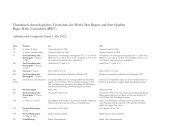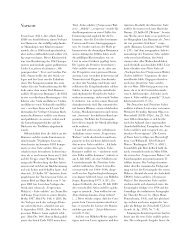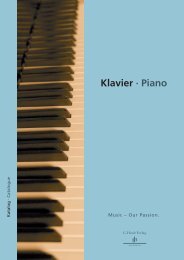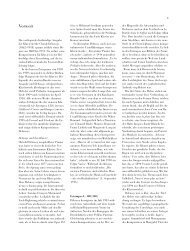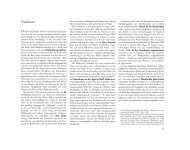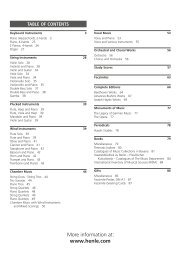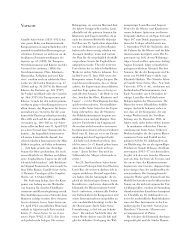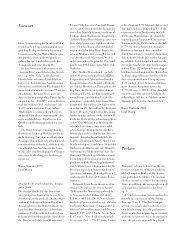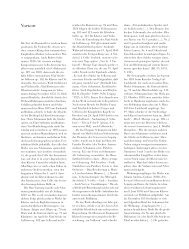Vorwort (PDF, 1698 KB) - Henle Verlag
Vorwort (PDF, 1698 KB) - Henle Verlag
Vorwort (PDF, 1698 KB) - Henle Verlag
You also want an ePaper? Increase the reach of your titles
YUMPU automatically turns print PDFs into web optimized ePapers that Google loves.
XXVII<br />
Davidsbündlertänze op. 6<br />
In the introduction to the edition of his<br />
collected writings, Schumann described a<br />
league, founded by himself, that “existed<br />
only in the mind of its creator: the Davidsbündler.<br />
In order to lend expression to various<br />
views on the nature of art, it seemed not<br />
entirely inappropriate to invent several contrasting<br />
artistic personalities, the most important<br />
being Florestan and Eusebius. […]<br />
This ‘League of David’ pervaded the entire<br />
journal (the NEUE ZEITSCHRIFT FÜR MUSIK,<br />
which Schumann had founded) like a red<br />
thread, amusingly uniting ‘truth and fiction’.”<br />
One should also add that this League<br />
of David had, of course, a quite specific purpose:<br />
to wage war against everything obsolete,<br />
backward-looking, and unpoetical – or<br />
what was then known as “philistine” – in the<br />
arts. It is no coincidence that the figure who<br />
lent his name to the league was the biblical<br />
David, the boy-hero who emerged victorious<br />
from his battle with Goliath, the leader<br />
of the Philistines, and who would later, as<br />
king, dance and play the harp before the<br />
Arc of the Covenant.<br />
The title of the final piece in Schumann’s<br />
Carnaval – Marche des Davidsbündler<br />
contre les Philistins – might well serve as a<br />
motto for the entire import of Schumann’s<br />
Davidsbund. Indeed, both Carnaval and<br />
the Davidsbündlertänze are thus closely<br />
interrelated. When Clara Wieck, in a letter<br />
of 3 February 1838, was somewhat reticent<br />
about the new pieces (she confessed that<br />
“they often bear too close a resemblance to<br />
Carnaval, my favourite among the smaller<br />
pieces you’ve written”), Schumann objected<br />
strenuously and proposed the following comparison:<br />
“I feel that they are quite different<br />
from Carnaval, having the same relation to<br />
that piece as faces do to masks.”<br />
Revealingly, the names of Florestan and<br />
Eusebius, the most important members of<br />
the secretive “League of David,” also crop<br />
up in Carnaval. These two figures are<br />
meant to embody Schumann’s own dual<br />
personality, with Florestan representing his<br />
impulsive and excitable, albeit occasionally<br />
brooding side, and Eusebius his gentle and<br />
retiring nature.<br />
Ultimately Florestan and Eusebius play<br />
the leading roles in the Davidsbündlertänze,<br />
for Schumann alternately credits them with<br />
the authorship of the pieces, which thereby<br />
take on characteristic attributes of their<br />
personalities.<br />
The Davidsbündlertänze originated in<br />
the late summer of 1837. On 21 September,<br />
Schumann wrote to composer Adolph<br />
Henselt: “I have just turned out eighteen<br />
Davidsbündlertänze – in the midst of my<br />
storm-tossed life.” The latter allusion refers<br />
to the secret engagement that he had<br />
entered into with Clara Wieck on 15 August<br />
after months of separation. Fittingly, his relations<br />
with Clara are clearly highlighted in<br />
the new work, above all in its introductory<br />
Motto von C. W., borrowed from a mazurka<br />
in Clara’s Soirées musicales (op. 6). Writing<br />
to his teacher Heinrich Dorn on 5 September<br />
1839, he remarked in retrospect that<br />
“the Concerto, the Sonata, the Davids bündler<br />
tänze, the Kreisleriana, and the Novelletten<br />
were practically all occasioned by<br />
Clara alone.”<br />
On 15 August Clara had accepted Schumann’s<br />
proposal of marriage. The composer<br />
was elated: On 5 January 1838, he confided<br />
that the dances contain “many thoughts of<br />
our wedding – they originated in the most<br />
splendid state of excitement I can ever recall.”<br />
On 7 February, after having a particularly<br />
lavish copy of the work dispatched to<br />
her, he confessed to her that “whatever the<br />
dances contain, my Clara will find it out, for<br />
they are more her own than anything else I<br />
have written. The whole story is a Polterabend<br />
[an eve-of-wedding party], and you<br />
can now picture its beginning and its ending.<br />
If I have ever been happy at the piano, it<br />
was when I composed these pieces.”<br />
Nevertheless, as already mentioned,<br />
Clara herself evidently had problems in understanding<br />
the new work. It was not until<br />
after Schumann’s death that she took the



